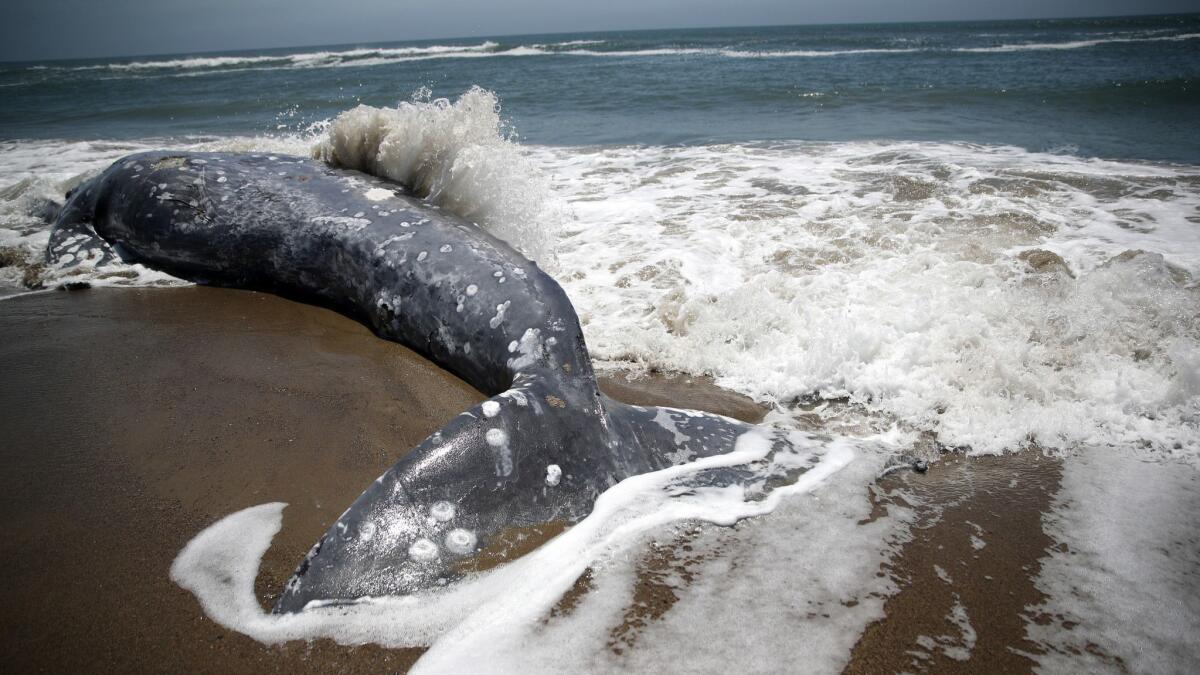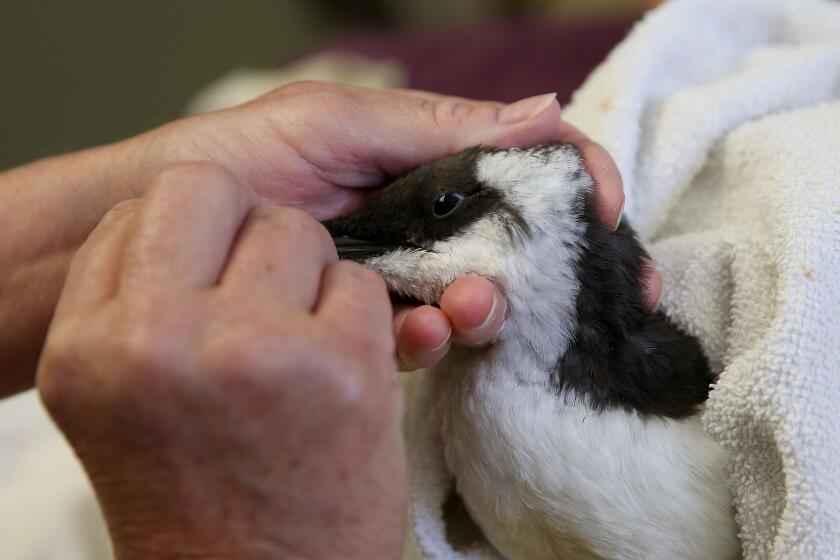As gray whale migration reaches its peak, scientists fear another unexplained die-off

- Share via
CARMEL, Calif. — As California gray whales wind their way south along North America’s Pacific coast — from their feeding grounds in the Arctic to their spring destination in the secluded lagoons of Mexico’s Baja Peninsula — researchers from Alaska to Mexico are watching, worried about another year of unexplained die-offs.
So far, at least three whales have died on the southbound journey, according to a spokesman at the U.S. National Oceanic and Atmospheric Administration. And there are unconfirmed reports of strandings in Mexico.
Necropsies suggest two of the confirmed whales were “thin,” while a third, a juvenile, seemed to be of average body condition, said NOAA’s Michael Milstein.
Last spring and summer, 215 whales inexplicably washed up along North America’s West Coast, suggesting thousands more had also perished but had sunk at sea. Concerned, NOAA called for an investigation in May, bringing together researchers from the Arctic to Mexico to explore the strandings in a uniform, systematic manner.
Protocols for nutritional observations during necropsies were established — providing a numeric scale upon which to assess blubber dryness, body condition and the best angles with which to photograph a beached whale. Regular phone calls and check-ins among geographically scattered scientists were also instituted.
Yet, according to Milstein and scientists involved with the investigation, it’s still unclear what caused the 2019 die-off and whether the whales will fare better this year.
A similar “unexplained mortality event” occurred in 2000. No cause was ever determined.
“We really won’t know anything until about February or March,” said John Calambokidis, a whale researcher at Cascadia Research, a nonprofit in Olympia, Wash. That’s when observers in the Baja lagoons will be able to examine the whales’ physical condition.
California gray whales migrate 5,000 miles every year from their summer feeding grounds in the Arctic to their calving grounds in the lagoons of Mexico’s Baja Peninsula, where they typically stay until the end of March and early April, before heading back north.
Their journey is the longest mammalian migration, and full of perils such as ships, orcas and plastic debris. The journey north is particularly perilous because gray whales only eat while in the Arctic; therefore, they are running on empty as they make their return trip from Baja.
“We’ll get a really good idea how they are doing in May or June as they pass by California, Oregon, Washington and B.C.,” said Calambokidis.
Data and observations collected this past summer by researchers based at NOAA’s Alaska Fisheries Science Center — where researchers each year conduct aerial surveys of whales, seals and other marine animals in the U.S. Arctic — have raised more questions than answers.
For instance, 15 gray whales were spotted in one day in the eastern Beaufort Sea — a rare sighting for a species usually seen getting fat at what the team up here likes to call “the Chukchi Sea buffet.” But with the sea ice forming later in winter and breaking up earlier in the summer, scientists wonder whether gray whales will continue to move farther east to new feeding areas.
When in their feeding grounds, a gray whale typically eats about 1.3 tons of food — mouth-fulls of crustaceans, worms, shrimp and small, schooling fish — per day, according to researchers.
In addition to changes in food availability, as sea ice decreases, whales are running into more and more ship traffic in these remote waters, said Amy Willoughby, a NOAA Fisheries marine mammal biologist at the Alaska center. Vessel strikes and entanglement in fishing gear are common causes of whale injury and death.
In an October post that Willoughby wrote after the latest aerial survey, she shared photos of a gray whale spotted in the northeastern Chukchi Sea with long, noticeable scars from the propeller of a small recreational vessel. Aerial photos —which allow scientists to see both left and right sides of the body and sometimes even the body below the surface — provide important health assessments and critical monitoring in this rapidly-changing polar environment, she said.
Maggie Mooney-Seus, spokeswoman for the Alaska Fisheries Science Center, said the team is busy this month figuring out how to best study what’s happening to the whales — and all the other changes — in the Arctic. “We are working with partners,” she said, “to determine future whale research initiatives that may help shed light on this and other relevant questions.”
Scientists are also looking at broader ocean conditions along the West Coast, such as an alarming rise in acidity and recent heat waves.
A new study suggests that a ‘blob’ of warm ocean water in 2015 disrupted the food web of the Pacific, triggering the starvation and deaths of thousands and thousands of sea birds, including the common murre.
Further down the coast, at Granite Point, just south of Carmel, researchers with NOAA’s Southwest Fisheries Science Center are using drones to count the whales as they move south.
So far, according to Trevor Joyce, a researcher with the southwest science center, the method seems effective — and much safer than sending observers out in low-flying planes. With help from a team of binocular-holding observers and three infrared sensors attached to the roof of a government shed on the Granite Canyon bluff, the counts are becoming more accurate.
Images captured last weekend by the drone shows the whales are at peak migration. More than 60 swam by the point, just south of Point Lobos, on Saturday — including a mother and her newborn calf.
The whales generally give birth as they move south, said Wayne Perryman, a retired NOAA biologist, who noted it’s also the time at which females ovulate, if they are not pregnant.
On a recent trip out of Ventura Harbor, a Times reporter spotted a pair of gray whales courting just north of Santa Cruz Island. A pod of more than a thousand common dolphins churned the waters nearby, and a family of eight orcas cruised for unsuspecting sea lions, seals and baby whales.
“These whales are the jeeps of the cetacean group,” said Perryman, noting not only the multitude of hazards they face — from annual 10,000 mile journeys, to ship strikes, changes in sea ice and predators — but also the whales’ adaptability.
“So if they start showing problems,” he said, it’s a potential flag for the ocean system as a whole.
More to Read
Sign up for Essential California
The most important California stories and recommendations in your inbox every morning.
You may occasionally receive promotional content from the Los Angeles Times.













